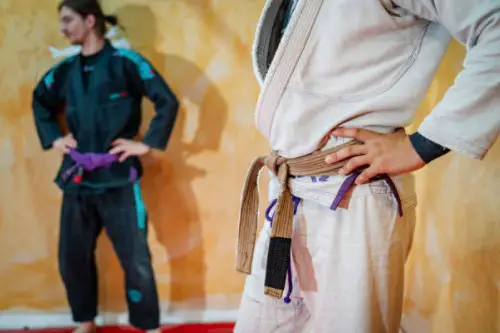If you are thinking about starting to learn Jiu-Jitsu or are just plain curious you might be thinking about what are the differences between Gracie Jiu-Jitsu and Brazilian Jiu-Jitsu. I am here today to try my best to explain what makes these two Jiu-Jitsu styles different.
The main difference between the Brazilian and Gracie variants of Jiu-Jitsu is that Brazilian Jiu-Jitsu is mainly taught as a combat sport first and self-defense technique second. Gracie Jiu-Jitsu is taught primarily as a self-defense technique that can be used in real-world fighting scenarios.
While the goal of use can be pinpointed as the main difference between the two disciplines of Jiu-Jitsu, that does not, however, explain all that is different between them. This article will discuss the fundamental differences between the two and try to explain “Gracie Jiu-Jitsu Vs Brazilian Jiu-Jitsu”- what makes them different?

What Is Brazilian Jiu-Jitsu?
Brazilian Jiu-Jitsu (BJJ) is a form of martial art that focuses on ground fighting, submission holds, grappling, and energy-efficient fighting techniques. It was developed in Brazil when a group of people learned Japanese Jiu-Jitsu and decided to modify it for themselves.
Brazilian Jiu-Jitsu’s primary goal is to develop a fighting style where a smaller and weaker fighter could defend themselves against a larger and stronger opponent. From its earliest Brazilian Jiu-Jitsu has been about the small guy defeating the large guy.
Brazilian Jiu-Jitsu has developed to the point where now no similarity between it and Judo can be found. It has grown into one of the largest combat sports in the modern world. Brazilian Jiu-Jitsu focuses heavily on the sport aspect of it. The founding of UFC (Ultimate Fighting Championship) in 1993 heavily helped establish Brazilian Jiu-Jitsu’s place as a sports-oriented martial art.
What Is Gracie Jiu-Jitsu?
Gracie Jiu-Jitsu (GJJ) evolved from Brazilian Jiu-Jitsu itself. The Gracie Jiu-Jitsu style was later established as a separate discipline that focused more on the self-defense aspect rather than fighting in sporting events.
All fighting techniques in Gracie Jiu-Jitsu are developed to be able to use it for self-defense and in real-world fighting scenarios. If it’s not useful in an actual fight then it is not Gracie Jiu-Jitsu.
Techniques that are often not used in traditional Brazilian Jiu-Jitsu are practiced heavily in Gracie Jiu-Jitsu because of their effectiveness in real-world fights. Gracie Jiu-Jitsu moves the focus away from using physical attributes and focuses on universal attacks that can be done by anyone to defeat their opponent.
Gracie Jiu-Jitsu Vs. Brazilian Jiu-Jitsu
Now that we know what both Gracie Jiu-Jitsu and Brazilian Jiu-Jitsu are, we can discuss in detail the differences between these two disciplines. I will try to pinpoint the key attributes and explain their primary differences here; which stem from their origin, technique, and application.
Origins
While Brazilian Jiu-Jitsu was born from Japanese Jiu-Jitsu and Judo, Gracie Jiu-Jitsu was born from Brazilian Jiu-Jitsu itself. Helio Gracie was very impressed by Maeda’s fighting and wanted to learn the style he was teaching to his brother but he was very frail. So, he had to adapt the technique to increase energy efficiency and reduce strain.
Slowly he became an expert at this style he was developing for himself. Although he was very fragile, he was successful in defeating opponents of other fighting disciplines much bigger and stronger than him with sheer technique alone.
His style of Brazilian Jiu-Jitsu kept on being developed as a form of combat sport. The many different masters of Brazilian Jiu-Jitsu would often do open challenges where fighters from other disciplines would come and try to defeat them.
The practitioners of Brazilian Jiu-Jitsu gained notoriety for their undefeated nature. Later on, the establishment of the UFC (Ultimate Fighting Championship) helped establish Brazilian Jiu-Jitsu as more of a sport.
On the other hand, Rorion Gracie, son of Helio Gracie, established the name of “Gracie Jiu-Jitsu”. His academy and those who are affiliated with it made changes to the techniques and focused more on the self-defense part of the martial art.
Gracie Jiu-Jitsu moved away from the sport aspect of its counterpart and veered more towards the real-world applications. Self-defense and techniques that could be used in real-world fights are what the pioneers of this discipline focused on. The combat-sport aspect of it all was pushed to the side and made a secondary concern.
Technique
The core fundamentals of both disciplines, Brazilian Jiu-Jitsu and Gracie Jiu-Jitsu overlap a lot and there are indeed a lot of similarities. However, when it comes to the question of which techniques can be considered as part of Brazilian Jiu-Jitsu and which techniques can be considered as part of Gracie Jiu-Jitsu, the differences start to become more clear.
If a technique should be incorporated within Gracie Jiu-Jitsu it needs to pass through a certain set of filters known as the “Gracie Filters”. These filters were set by the Gracie Jiu-Jitsu Academy.
First of all, it needs to be energy efficient which is similar to Brazilian Jiu-Jitsu. Next, it needs to be universally doable, any move that leverages any physical attributes such as weight, strength cannot be incorporated in Gracie Jiu-Jitsu, whereas, in Brazilian Jiu-Jitsu moves that use attributes are even encouraged.
Gracie Jiu-Jitsu needs to have moves that can be done by anyone. Finally, Gracie Jiu-Jitsu needs to have moves that are effective in an actual fight.
Brazilian Jiu-Jitsu techniques are taught more as a sport, with defense slowly moving to a secondary concern. Techniques that cannot be used in tournaments are not allowed in this discipline. Moves like punches and strikes are not allowed in Brazilian Jiu-Jitsu tournaments.
On the other hand, techniques in Gracie Jiu-Jitsu are developed to use them to defend themselves and use them in a real fight.
Application
The application factor of both of these disciplines is what defines their core philosophies. For Brazilian Jiu-Jitsu the sports and competitive usage of martial art is what comes first, self-defense and real-world applications come second.
Whereas in Gracie Jiu-Jitsu the self-defense and real-world applications are what comes first, the competitive usage is pushed aside.
Gracie Jiu-Jitsu focuses its training on how someone could use these techniques and win a real fight in an actual hostile situation. Gracie Jiu-Jitsu is sometimes even referred to as “Street Jiu-Jitsu” because of its emphasis on effectiveness in real-world fights.
A person learning Gracie Jiu-Jitsu is learning so that they could hopefully handle a situation where they could be in a situation that would require them to defend themselves against someone attacking them.
They also prepare so that they do not fail to fend for themselves if they need to fight someone for real. Using their fighting technique for sport is not their objective.
In opposition to that, anyone learning Brazilian Jiu-Jitsu does so for the sport itself. Their training focuses on combating opponents in a tournament setting where they have to abide by a certain set of rules and regulations while doing battle.
Conclusion
Both Brazilian Jiu-Jitsu and Gracie Jiu-Jitsu are very nuanced sections of martial art with a rich history and a vast amount of variety.
The key differences between Gracie Jiu-Jitsu and Brazilian Jiu-Jitsu come from their different origins, their development processes, and the use case they are each created for. GJJ focuses more on a self-defense route while BJJ focuses more on the competition route.
Both forms of Jiu-Jitsu are legitimate forms of fighting and useful. The one you choose comes down to which aspect of the art you want to focus on more. Both GJJ and BJJ can be used to defend yourself and be used in competition.
Hope that my efforts here to briefly and easily describe Gracie Jiu-Jitsu Vs. Brazilian Jiu-Jitsu helped with the questions you had about this topic. If you were looking for the differences because you want to start learning, I hope that you are now able to make a decision that is right for you now. Thank you for reading until the end.


